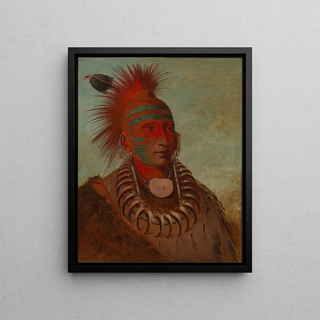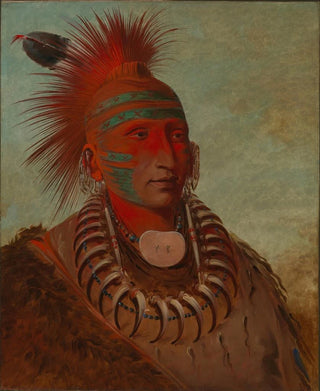Art print | No-ho-mun-ya The one who pays no attention - George Catlin


View from behind

Frame (optional)
At the heart of 19th-century American art, the artwork "No-ho-mun-ya The One Who Pays No Attention" by George Catlin stands as a poignant testament to Native American culture. Capturing the very essence of a people on the brink of oblivion, this painting invites viewers to immerse themselves in a universe rich in traditions and spirituality. Through the piercing gaze of the depicted figure, Catlin prompts us to reflect on the relationship between man and nature, as well as the importance of collective memory. This piece, a true window into a changing world, still resonates today with extraordinary force, reminding us of the beauty and fragility of indigenous cultures.
Style and uniqueness of the artwork
The uniqueness of "No-ho-mun-ya" lies in how Catlin manages to blend realism and symbolism. The vibrant colors and meticulous details of the composition reveal not only the artist's technical skill but also his deep respect for the subjects he portrays. The character, dressed in traditional attire, seems to emanate ancestral wisdom, while the background landscape evokes the vast expanses these peoples traversed. The use of light and shadow helps create an almost mystical atmosphere, reinforcing the idea that this frozen moment in time is charged with multiple meanings. Every brushstroke appears to tell a story, a legend, a forgotten truth, inviting viewers to question their own place in this narrative.
The artist and his influence
George Catlin, artist and adventurer, dedicated his life to documenting the lifestyles of Native American tribes, becoming one of the first to give voice to them through art. His passion for faithfully representing the cultures he encountered allowed him to create a monumental body of work that transcends eras. By immersing himself in the rituals, customs, and landscapes of the peoples he painted, Catlin not only created a remarkable artistic corpus but also played a crucial role in preserving Native American heritage. His

Matte finish

View from behind

Frame (optional)
At the heart of 19th-century American art, the artwork "No-ho-mun-ya The One Who Pays No Attention" by George Catlin stands as a poignant testament to Native American culture. Capturing the very essence of a people on the brink of oblivion, this painting invites viewers to immerse themselves in a universe rich in traditions and spirituality. Through the piercing gaze of the depicted figure, Catlin prompts us to reflect on the relationship between man and nature, as well as the importance of collective memory. This piece, a true window into a changing world, still resonates today with extraordinary force, reminding us of the beauty and fragility of indigenous cultures.
Style and uniqueness of the artwork
The uniqueness of "No-ho-mun-ya" lies in how Catlin manages to blend realism and symbolism. The vibrant colors and meticulous details of the composition reveal not only the artist's technical skill but also his deep respect for the subjects he portrays. The character, dressed in traditional attire, seems to emanate ancestral wisdom, while the background landscape evokes the vast expanses these peoples traversed. The use of light and shadow helps create an almost mystical atmosphere, reinforcing the idea that this frozen moment in time is charged with multiple meanings. Every brushstroke appears to tell a story, a legend, a forgotten truth, inviting viewers to question their own place in this narrative.
The artist and his influence
George Catlin, artist and adventurer, dedicated his life to documenting the lifestyles of Native American tribes, becoming one of the first to give voice to them through art. His passion for faithfully representing the cultures he encountered allowed him to create a monumental body of work that transcends eras. By immersing himself in the rituals, customs, and landscapes of the peoples he painted, Catlin not only created a remarkable artistic corpus but also played a crucial role in preserving Native American heritage. His






